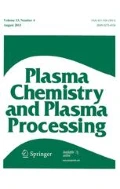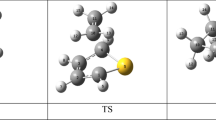Abstract
Here, we compared the conversion of gasoline-ranged n-alkanes (C6–C9) using dielectric barrier discharge. For an energy density of ~68 J/L and an initial n-alkane concentration of ~230 ppm, when carbon number increased from 6 to 9, the energy efficiency of n-alkane conversion increased from 117 to 240 mmol/kWh, CO x selectivity decreased from 46 to 20%, and ozone concentration increased from 216 to 240 ppm. The effect of energy density and initial n-alkane concentration were also investigated. The understanding of initial step of conversion was greatly aided by a proposed kinetic model. The pathways of consecutive reactions from the initiation to products were also discussed.









Similar content being viewed by others
References
Odman MT, Hu Y, Russell AG, Hanedar A, Boylan JW, Brewer PF (2009) Quantifying the sources of ozone, fine particulate matter, and regional haze in the Southeastern United States. J Environ Manag 90:3155–3168
Morris RE, Koo B, Guenther A, Yarwood G, McNally D, Tesche TW, Tonnesen G, Boylan J, Brewer P (2006) Model sensitivity evaluation for organic carbon using two multi-pollutant air quality models that simulate regional haze in the southeastern United States. Atmos Environ 40:4960–4972
Mao T, Wang Y, Jiang J, Wu F, Wang M (2008) The vertical distributions of VOCs in the atmosphere of Beijing in autumn. Sci Total Environ 390:97–108
Hu M, He L, Huang X, Wu Z (2009) The characteristics, sources, formation mechanism of atmospheric fine particles and ultra-fine particles over Beijing. Science Publication, Beijing
Cai C, Geng F, Tie X, Yu Q, An J (2010) Characteristics and source apportionment of VOCs measured in Shanghai, China. Atmos Environ 44:5005–5014
Hoekman SK (1992) Speciated measurements and calculated reactivities of vehicle exhaust emissions from conventional and reformulated gasolines. Environ Sci Technol 26:1206–1216
Kirchstetter TW, Singer BC, Harley RA, Kendall GR, Traverse M (1999) Impact of California reformulated gasoline on motor vehicle emissions. 1. Mass emission rates. Environ Sci Technol 33:318–328
McArragher JS, Betts WE, Kiessling D, Pearson JK, Schug KP, Snelgrove DG, Wauquier X, Brandt J (1988) The control of vehicle evaporative and refueling emissions—the “on-board” system. Report no. 88/62, Prepared by CONCAWE AE/STF-1
Zhang X, Cha M (2015) Partial oxidation of methane in a temperature-controlled dielectric barrier discharge reactor. Proc Combust Inst 35:3447–3454
Vandenbroucke AM, Morent R, Geyter ND, Leys C (2011) Non-thermal plasmas for non-catalytic and catalytic VOC abatement. J Hazard Mater 195:30–54
Zhao D, Li X, Shi C, Fan H, Zhu A (2011) Low-concentration formaldehyde removal from air using a cycled storage–discharge (CSD) plasma catalytic process. Chem Eng Sci 66:3922–3929
Hoeben W, Boekhoven W, Beckers F, Heesch EJM, Pemem AJ (2014) Partial oxidation of methane by pulsed corona discharges. J Phys D Appl Phys 47:355202
Mizuno A (2007) Industrial applications of atmospheric non-thermal plasma in environmental remediation. Plasma Phys Control Fusion 49:A1–A15
Winands GJJ, Liu Z, Heesch EJM, Pemen AJ, Yan K (2008) ADS and CDS streamer generation as function of pulse parameters. IEEE Trans Plasma Sci 36:926–927
Feng F, Zheng Y, Shen X, Zheng Q, Dai S, Zhang X, Huang Y, Liu Z, Yan K (2015) Characteristics of back corona discharge in a honeycomb catalyst and its application for VOCs treatment. Environ Sci Technol 49:6831–6837
Jiang N, Lu N, Shang K, Li J, Wu Y (2013) Innovative approach for benzene degradation using hybrid surface/packed-bed discharge plasmas. Environ Sci Technol 47:9898–9903
Jo S, Lee DH, Song YH (2015) Product analysis of methane activation using noble gases in a non-thermal plasma. Chem Eng Sci 130:101–108
Shi C, Zhang Z, Crocker M, Xu L, Wang C, Au C, Zhu A (2013) Non-thermal plasma-assisted NO x torage and reduction on a LaMn0.9Fe0.1O3 perovskite catalyst. Catal Today 211:96–103
Nozaki T, Okazaki K (2013) Non-thermal plasma catalysis of methane: principles, energy efficiency, and applications. Catal Today 211:29–38
Zhu X, Liu S, Cai Y, Gao X, Zhou J, Zheng C, Tu X (2016) Post-plasma catalytic removal of methanol over Mn–Ce catalysts in an atmospheric dielectric barrier discharge. Appl Catal B: Environ 183:124–132
Ramirez A, Rico VJ, Cotrino J, Elipe AR, Lambert RM (2014) Low temperature production of formaldehyde from carbon dioxide and ethane by plasma-assisted catalysis in a ferroelectrically moderated dielectric barrier discharge reactor. ACS Catal 4:402–408
Zhang X, Cha M (2013) Electron-induced dry reforming of methane in a temperature-controlled dielectric barrier discharge reactor. J Phys D Appl Phys 46:415205
Yan K, Heesch EJM, Pemen AJ, Huijbrechts PA (2001) From chemical kinetics to streamer corona reactor and voltage pulse generator. Plasma Chem Plasma Process 21:107–137
Yan N, Qu Z, Jia J, Wang X, Wu D (2006) Removal characteristics of gaseous sulfur-containing compounds by pulsed corona plasma. Ind Eng Chem Res 45:6420–6427
Zhang X, Chen W, Zhu J, Feng W, Yan K (2013) Aerosol formation and decomposition of benzene derivatives by AC/DC streamer corona discharge. Int J Plasma Environ Sci Technol 4:130–134
Hill SL, Kim HH, Futamura S, Whitehead JC (2008) The destruction of atmospheric pressure propane and propene using a surface discharge plasma reactor. J Phys Chem A 112:3953–3958
Yao S, Weng S, Jin Q, Lu H, Wu Z, Zhang X, Han J, Lu H, Tang X, Jiang B (2016) Mechanism of decane decomposition in a pulsed dielectric barrier discharge reactor. IEEE Trans Plasma Sci 44:1–7
Marotta E, Callea A, Rea M, Paradisi C (2007) DC corona electric discharges for air pollution control, part 1. Efficiency and products of hydrocarbon processing. Environ Sci Technol 41:5862–5868
Pekarek S, Pospisil M, Krysa J (2006) Non-thermal plasma and TiO2-assisted n-heptane decomposition. Plasma Process Polym 3:308–315
Zhang X, Cha M (2016) Tailored reforming of n-dodecane in an aqueous discharge reactor. J Phys D Appl Phys 49:175201
Thagard SM, Prieto G, Takashima K, Mizuno A (2012) Identification of gas-phase by-products formed during electrical discharges in liquid fuels. IEEE Trans Plasma Sci 40:2106–2111
Yao S, Weng S, Tang Y, Zhao C, Wu Z, Zhang X, Yamamoto S, Kodama S (2016) Characteristics of OH production by O2/H2O pulsed dielectric barrier discharge. Vacuum 126:16–23
Kogelschatz U (2003) Dielectric-barrier discharges: their history. Discharge physics, and industrial applications. Plasma Chem Plasma Process 23:1–46
Mikoviny T, Kocan M, Matejcik S, Mason NJ, Skalny JD (2004) Experimental study of negative corona discharge in pure carbon dioxide and its mixtures with oxygen. J Phys D Appl Phys 37:64–73
Goujard V, Nozaki T, Yuzawa S, Agiral A, Okazaki K (2011) Plasma assisted partial oxidation of methane at low temperatures: number analysis of gas-phase chemical mechanism. J Phys D Appl Phys 44:274011
http://kinetics.nist.gov/. Last accessed at 15th June 2016
Yao S, Wu Z, Han J, Tang X, Jiang B, Lu H, Yamamoto S, Kodama S (2015) Study of ozone generation in an atmospheric dielectric barrier discharge reactor. J Electrostat 75:35–42
Seinfeld JH, Pandis SN (1998) Atmospheric chemistry and physics: from air pollution to climate change. Wiley, New York
Jin Q, Jiang B, Han J, Yao S (2016) Hexane decomposition without particle emission using a novel dielectric barrier discharge reactor filled with porous dielectric balls. Chem Eng J 286:300–310
Acknowledgements
This work was financially supported by the National Natural Science Foundation of China (No. 51206146), the Program for Zhejiang Leading Team of S&T Innovation (No. 2013TD07) and the Science and Technology Project of Zhejiang Province (No. 2017C33042).
Author information
Authors and Affiliations
Corresponding author
Rights and permissions
About this article
Cite this article
Yao, S., Weng, S., Jin, Q. et al. Comparison of Gasoline-Ranged n-Alkanes Conversions Using Dielectric Barrier Discharge: A Kinetic Study. Plasma Chem Plasma Process 37, 137–148 (2017). https://doi.org/10.1007/s11090-016-9768-4
Received:
Accepted:
Published:
Issue Date:
DOI: https://doi.org/10.1007/s11090-016-9768-4




